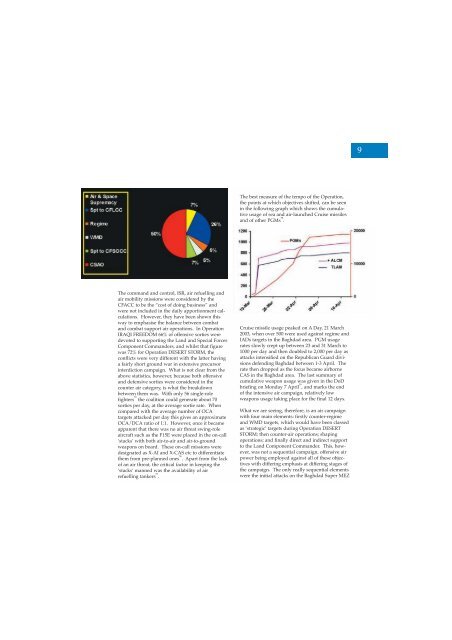Volume 6 No 4 - Royal Air Force Centre for Air Power Studies
Volume 6 No 4 - Royal Air Force Centre for Air Power Studies
Volume 6 No 4 - Royal Air Force Centre for Air Power Studies
Create successful ePaper yourself
Turn your PDF publications into a flip-book with our unique Google optimized e-Paper software.
9<br />
The best measure of the tempo of the Operation,<br />
the points at which objectives shifted, can be seen<br />
in the following graph which shows the cumulative<br />
usage of sea and air-launched Cruise missiles<br />
and of other PGMs 58 .<br />
The command and control, ISR, air refuelling and<br />
air mobility missions were considered by the<br />
CFACC to be the “cost of doing business” and<br />
were not included in the daily apportionment calculations.<br />
However, they have been shown this<br />
way to emphasise the balance between combat<br />
and combat support air operations. In Operation<br />
IRAQI FREEDOM 66% of offensive sorties were<br />
devoted to supporting the Land and Special <strong>Force</strong>s<br />
Component Commanders, and whilst that figure<br />
was 72% <strong>for</strong> Operation DESERT STORM, the<br />
conflicts were very different with the latter having<br />
a fairly short ground war in extensive precursor<br />
interdiction campaign. What is not clear from the<br />
above statistics, however, because both offensive<br />
and defensive sorties were considered in the<br />
counter air category, is what the breakdown<br />
between them was. With only 56 single-role<br />
fighters 55 the coalition could generate about 70<br />
sorties per day, at the average sortie rate. When<br />
compared with the average number of OCA<br />
targets attacked per day this gives an approximate<br />
OCA/DCA ratio of 1:1. However, once it became<br />
apparent that there was no air threat swing-role<br />
aircraft such as the F15E were placed in the on-call<br />
‘stacks’ with both air-to-air and air-to-ground<br />
weapons on board. These on-call missions were<br />
designated as X-AI and X-CAS etc to differentiate<br />
them from pre-planned ones 56 . Apart from the lack<br />
of an air threat, the critical factor in keeping the<br />
‘stacks’ manned was the availability of air<br />
refuelling tankers 57 .<br />
Cruise missile usage peaked on A Day, 21 March<br />
2003, when over 500 were used against regime and<br />
IADs targets in the Baghdad area. PGM usage<br />
rates slowly crept up between 23 and 31 March to<br />
1000 per day and then doubled to 2,000 per day as<br />
attacks intensified on the Republican Guard divisions<br />
defending Baghdad between 1-3 April. The<br />
rate then dropped as the focus became airborne<br />
CAS in the Baghdad area. The last summary of<br />
cumulative weapon usage was given in the DoD<br />
briefing on Monday 7 April 59 , and marks the end<br />
of the intensive air campaign, relatively low<br />
weapons usage taking place <strong>for</strong> the final 12 days.<br />
What we are seeing, there<strong>for</strong>e, is an air campaign<br />
with four main elements: firstly counter-regime<br />
and WMD targets, which would have been classed<br />
as ‘strategic’ targets during Operation DESERT<br />
STORM; then counter-air operations; shaping<br />
operations; and finally direct and indirect support<br />
to the Land Component Commander. This, however,<br />
was not a sequential campaign, offensive air<br />
power being employed against all of these objectives<br />
with differing emphasis at differing stages of<br />
the campaign. The only really sequential elements<br />
were the initial attacks on the Baghdad Super MEZ
















